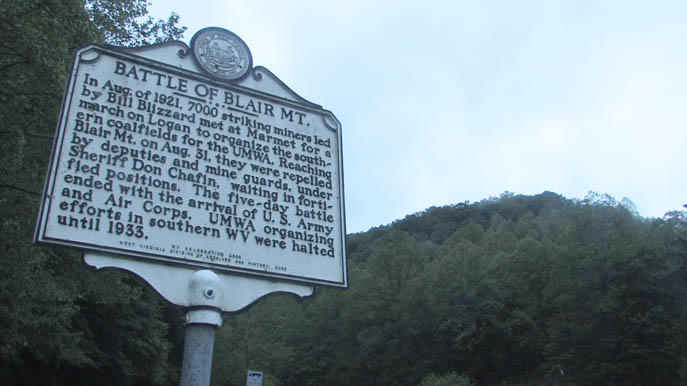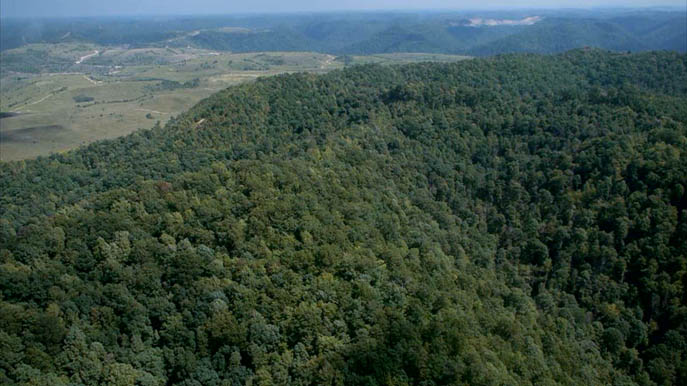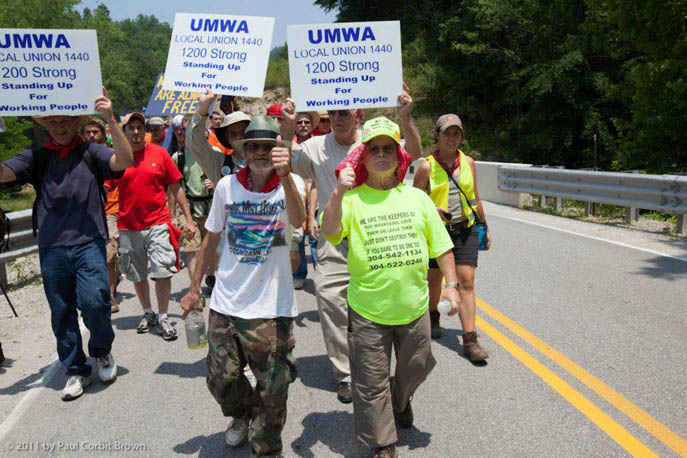
Battle of Blair Mountain historical marker. Photo by Jordan Freeman.
In 1921, 10,000 men –- coal miners on one side and hired guns for the mine owners on the other -– fought a pitched battle at Blair Mountain in West Virginia over the right of the miners to organize. Although the miners laid down their guns when National Guard troops arrived, they eventually succeeded in their efforts to form unions to fight for fair wages and safer working conditions. The Battle of Blair Mountain occurred almost 100 years ago, but the fight goes on to put the needs of miners -– as well as the environment and the communities that bear the brunt of mining’s destructive impacts -– above corporate greed.
As the nation’s energy economy moves away from coal, mining companies are finding themselves in increasingly dire economic circumstances. But rather than transition gracefully, coal companies have turned from the bullets used at Blair Mountain to the intricacies of the Bankruptcy Code to continue to keep themselves afloat by chipping away at the rights of miners and others impacted by coal mining. When Peabody Energy filed for bankruptcy this week, it joined two of the other largest mine operators in the United States: Alpha Natural Resources and Arch Coal. That means that today almost half of all coal mined in the U.S. is produced by bankrupt mining companies. As they seek to reorganize and emerge from bankruptcy, these companies are not merely trying to shed excess debt and re-balance their ledgers. They are using the bankruptcy process to cut miners’ wages, strip away worker retirement and healthcare obligations, and to eliminate or minimize their environmental cleanup responsibilities. At the same time, and just as they always have, the coal companies are looking after their own. Arch Coal paid its executives $8 million in bonuses just one business day before the company filed for bankruptcy. In the Alpha bankruptcy, the company secured approval from the bankruptcy court to provide almost $12 million in bonuses for its existing executives for nothing more than doing their jobs while the company is in bankruptcy.

Blair Mountain from the air. Photo by Paul Corbit Brown.
These mine operator bankruptcies are not yet complete, however, so opportunities remain to require the companies to satisfy their obligations to the miners, the environment, and the communities. The United Mine Workers of America are playing an active role in the bankruptcies to protect the rights of their workers and other miners. In addition, Sierra Club is participating in the bankruptcies to ensure that all environmental protections and obligations –- including the legal requirements that mine operators reclaim the sites as they mine and provide additional financial assurances to cover the cost of reclamation should they liquidate –- remain in full effect. The Sierra Club is also strongly encouraging the U.S. Office of Surface Mining, Reclamation and Enforcement and other federal agencies to use their authorities and influence to hold the companies in check and prevent a further loosening of bedrock requirements under the law. Finally, the Sierra Club is advocating for robust public investment to protect Appalachian workers and communities and to retool the region’s economy, beginning with the RECLAIM Act which will invest a billion dollars in economic development in the region through abandoned mine reclamation.
The aura of invulnerability that has long surrounded coal companies –- particularly in states where they wield outsized influence –- is fading. Last month, a federal court sentenced former Massey Energy chief executive Don Blankenship to one year in prison for conspiring to violate federal mine safety standards. Blankenship’s prosecution was related to the fatal mine accident at the Upper Big Branch underground coal mine in West Virginia that took the lives of 29 miners. (Massey Energy was later acquired by the now-bankrupt Alpha Natural Resources). Although many in the communities impacted by Massey’s mines had hoped for conviction on additional counts that could have led to a longer sentence, at one time it was all but inconceivable that Blankenship would ever be held to account for his management approach which placed profits above all other considerations. Blankenship had long appeared to relish his role as a modern-day coal baron, and was known to vacation in the Mediterranean with sitting West Virginia Supreme Court justices who had a habit of handing down decisions favorable to Blankenship and his companies.

Blair Mountain march, June 2011, led by Larry Gibson. Photo by Paul Corbit Brown.
And this week a federal judge vacated a decision by the National Park Service’s Keeper of the National Register to remove the site of the Battle of Blair Mountain from the National Register of Historic Places. The Sierra Club and our local allies have long fought to have the Battlefield protected. Multiple coal mining permits overlap the Battlefield, and mining companies have made no secret of their desire to blow the historic site up and reduce it to rubble. In response to a petition submitted by Sierra Club and our partners, the Battlefield was listed on the National Register in March 2009. Just nine months later, following a concerted campaign by mine industry lawyers, the Keeper removed the site claiming irregularities in the listing procedures. But in a long and detailed decision, the U.S. District Court picked apart the arguments and bogus facts put forward by the coal companies and chastised the Keeper for rubber stamping the state’s recommendation that the site be removed from the Register. Although the Battlefield has not yet been restored to the Register, there remains an excellent chance that the site of a key battle in the original mine wars from 1921 will receive the historic protections it deserves.
The idea of coal barons commanding private armies is inconceivable in our modern day. It is time for our leaders and regulators to recognize that other vestiges of that era are equally outdated. Failing to embrace newer, cleaner technologies. Sacrificing the rights of workers to pad executives’ pockets. Allowing corporations to walk away and leave communities with the legacy of devastated landscapes and poisoned streams.

Mist on Blair Mountain. Photo by Jordan Freeman.